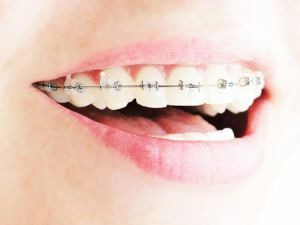 An ideally smooth row of teeth is a pledge of an attractive snow-white smile. Braces are one of the methods that you can give it.
An ideally smooth row of teeth is a pledge of an attractive snow-white smile. Braces are one of the methods that you can give it.
But when choosing this method of correction of occlusion, many people ask themselves( mainly for the sake of economy) - is it sufficient to partially fix braces on one of the jaws, or the bottom one, to correct their defect? In which cases can you do without a full installation, which, of course, is twice as expensive?
Contents of
- When and to whom is the partial correction recommended?
- When can braces be installed on one jaw?
- Lower row correction
- What constructions are used?
- Installation process
- Features of mandibular correction
- Braces mounting on the upper jaw
- What designs and materials are used?
- Installation process
- Features correction
- Option for adjusting 1-2 teeth
- Price issue
- When does it still need to adjust both jaws?
When and to whom is the partial correction recommended?
Situations when experts recommend setting braces only on the upper or lower jaw is very small - only 5% of the total number of cases. And that's why.
Far from orthodontics, it seems to people that the curvature of teeth is a small and easily removable problem. But this is not so. The curved position of the teeth is a consequence of the fact that the patient has an incorrect bite.
Its specialists determine by how the dentitions relative to each other are located when the jaws are closed. To resolve the situation it will help to correct the bite - then the problem with individual teeth will go away by itself.
The orthodontist may recommend placing braces on one of the jaws only in one case - with the right bite with slight curvature of the teeth or only one tooth.
When can braces be installed on one jaw?
If the occlusion is incorrect, the partial installation of the brackets will not help, but on the contrary it will do harm by exacerbating the problem, giving rise to a new 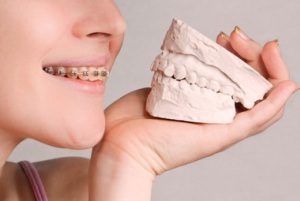 deformation of the dentition. However, there are a number of cases in which dentists consider it possible to install brackets on one jaw: the
deformation of the dentition. However, there are a number of cases in which dentists consider it possible to install brackets on one jaw: the
- has no serious bite problems, and the upper and lower jaws are symmetrical( much attention is paid to the location of canines and molars - they must be exactly opposite to each other);
- from the whole set of dentition slightly curved no more than two teeth.
Correction of the lower row
The orthodontist decides to use the braces only for the lower jaw only when the bite is almost perfect and the upper teeth are even and do not need correction. Often this happens, and if necessary, in the correction of only a couple of teeth.
However, be prepared for the fact that after the correction of the lower jaw you will need to vilify for some time the braces and on the top. The reason for this is the expansion of the lower row due to the wearing of the system. In order not to spoil the patient's bite, the doctor may advise you to adjust the upper position of the lower dentition by a new position.
What constructions do you use?
The following types of bracket-systems were the most widely known for partial correction:
- Metallic .The most common option because of its economy. Lower teeth are hidden behind the lip when talking or smiling - so there is an opportunity to save on the material. On the basis of the effectiveness of the correction, this species is in no way inferior to others.
- If the metal even in this case still seems unaesthetic, then at your choice are offered sapphire and ceramic correction systems .They are more expensive than metal, but, in addition to external attractiveness, they have one more advantage - less injuring tooth enamel.
- The most aesthetic appearance - lingual construction .It is completely invisible to others, as it is located on the inside of the jaw. Also, the lingual system can help to avoid problems with the closing of the teeth and subsequent changes in the bite. The only downside is its high price.
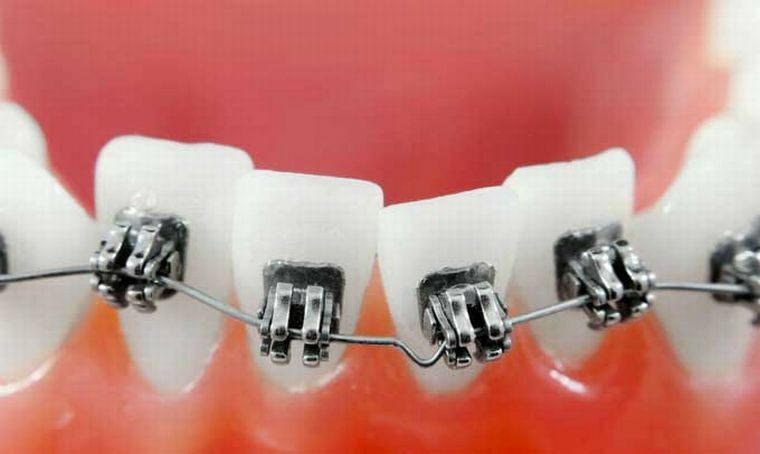
Installation process
Before installation it is important to undergo a thorough sanitation of the oral cavity:
- Control of caries .Braces are not an easy test for teeth, so it is necessary that the latter be in good condition. In addition, the orthodontic system itself can contribute to the development of infection - stuck food pieces in its details seem to be the ideal home for bacteria.
- Control of periodontal disease and with periodontitis .It is necessary to eliminate all inflammatory processes in the gum area, since periodontitis is very undesirable during the wearing of braces.
- Professional teeth cleaning .Produced by ultrasound or by means containing fluoride. Bracket designs are installed only on absolutely cleaned teeth, since plaque and all kinds of deposits interfere with the proper adhesion of surfaces and contribute to the development of dental infections.
Once all the preparatory stages have been completed, the installation process itself begins:
- For the convenience of the work, a special construction is inserted - the rotor expander. Polish teeth, inflate a special substance with a restoring effect. Then it is removed, the enamel is dried.
- A strong adhesive is applied to the surface of the enamel, the structure is attached to it. All its locks are covered with a layer of special "dental" cement. UV rays accelerate its solidification.
- The doctor carefully removes excess material. Installation completed.
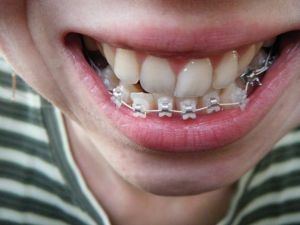 The fastest types are those types of structures that are attached to the outer surface - about an hour. Most of the time here is spent on the ultra-precise application of the glue - so as not to create the effect of an incorrect "traction".Lingual braces are installed longer due to the difficulties of working with the "hidden" surface of the jaw - about an hour and a half. Because, by the way, their cost is so high.
The fastest types are those types of structures that are attached to the outer surface - about an hour. Most of the time here is spent on the ultra-precise application of the glue - so as not to create the effect of an incorrect "traction".Lingual braces are installed longer due to the difficulties of working with the "hidden" surface of the jaw - about an hour and a half. Because, by the way, their cost is so high.
I must say that the installation is quite painless, although somewhat tedious.
Features of mandibular correction
A number of features inherent in the correction of defects in the lower teeth:
- bite problems are often somewhat more serious than with the upper jaw;
- the lower wrong bite is more difficult to correct;
- adjustment takes longer;
- the range of materials used is poorer;
- treatment of the lower row is usually cheaper than the upper.
Installation of braces on the upper jaw
The conditions for installing the corrective structure only on the upper row of teeth are exactly the same as on the bottom row: almost one hundred percent right bite and only one or two problem teeth.
What designs and materials are used?
Can be used as vestibular( external), or lingual( hidden on the inside of the dentition).
Different orthodontic systems can also be selected for the material: 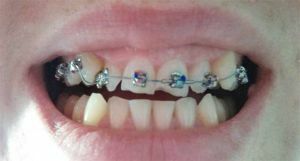
- metal ( medical steel or titanium);
- ceramic - externally transparent, but fairly sturdy;
- sapphire - almost invisible due to its transparency, but it is fragile enough;
- polymeric are also transparent, but with time they are painted under the influence of consumed food, this is compensated by their relative cheapness.
There is also a choice between classic ligature and ligatureless systems. In the first arc, braces are fastened with metal ligatures or elastic rings. They are distinguished by a lower cost and time-tested.
The latter have self-regulating mechanisms. Their advantages are a higher speed of installation, assistance in convenient oral hygiene, an individual "plan" for correcting each tooth, reducing the time of wearing the mechanism.
Installation process
Braces on the upper jaw are placed almost identically the same as on the bottom. The only installation takes a little less time.
Features of correction
For correcting the dentition of the upper jaw is characteristic:
- more patient appeals, this is not due to the fact that it is more problematic, but with the aesthetic component - the front teeth are more noticeable.
- because of the small crowding of teeth, correction of the occlusion of the upper row goes much faster;
- for the correction of deficiencies of the upper teeth developed more designs.
Option for adjusting 1-2 teeth
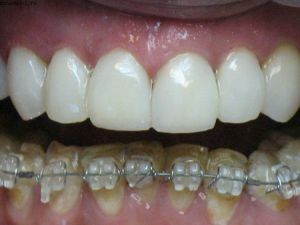 If the patient has a problem with one or two teeth, and in another correct bite, the dentist may suggest wearing removable caps. This kind of adjustment is characteristic for incisors and canines. Kaps may not fit the patient if the tooth is strongly turned to the side.
If the patient has a problem with one or two teeth, and in another correct bite, the dentist may suggest wearing removable caps. This kind of adjustment is characteristic for incisors and canines. Kaps may not fit the patient if the tooth is strongly turned to the side.
The advantages of this design are lower cost compared to braces, and a short period of wearing in a few months.
But at the same time, there are a number of drawbacks:
- it is difficult to achieve a common evenness of the whole set of teeth;
- are less convenient to use;
- , unlike braces, affects pronunciation.
Price of the issue
Estimated cost of the complete installation of braces for two jaws:
- metal : 8-20 thousand rubles;
- ceramic : 15-40 thousand rubles;
- sapphire : 18-70 thousand rubles;
- polymer : 12-15 thousand rubles;
- lingual : 30-80 thousand rubles;
- liquefied : 50-80 thousand rubles.
To know the approximate cost of installing a bracket system on just one jaw, it is enough to divide the total cost in half.
When do you need to adjust both jaws?
To put a bracket system on both jaws simultaneously the expert will advise, when problems with an occlusion at the patient considerable if the curvature is serious and has touched a few teeth.
Do not be particularly upset if this is your case. You will receive a comprehensive and effective treatment that will not allow the 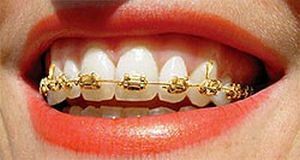 problem to return, nor will you acquire new dental pathologies due to the less expensive but incorrect way to correct the bite.
problem to return, nor will you acquire new dental pathologies due to the less expensive but incorrect way to correct the bite.
Summarizing all that has been said, it can be said that not all cases of correction of irregularities in the dentition require the installation of braces on both jaws. In the case of non-serious bite disorders or their absence, a small number of curved teeth can be corrected by installing a bracket construction on only one jaw.
However, with significant malocclusion, it is better to forget about saving and to listen to a specialist - to install a design on both dental rows. It will still be cheaper to correct pathologies caused by an incorrect approach to treatment.
